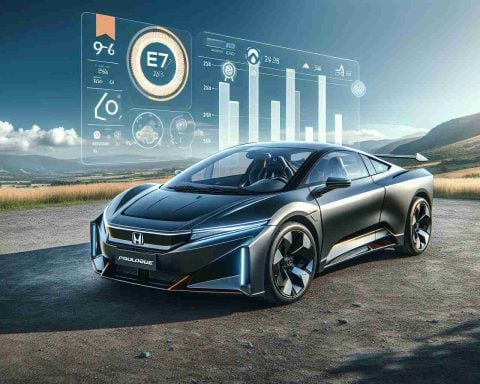- The UK’s automotive market is experiencing a major shift towards electric vehicles (EVs), with plug-in EVs reaching 40% of December’s car sales.
- Battery electric vehicles (BEVs) alone hit a record high of 31% in December, driven by the upcoming 2024 Zero Emission Vehicle (ZEV) mandate.
- Tesla leads the market, with its Model Y becoming particularly popular among UK consumers.
- ZEV credits have become critical for manufacturers like Toyota and Ford to avoid penalties, highlighting disparities between EV specialists and traditional automakers.
- Stricter regulations in 2024 will close loopholes on credit purchases, pushing all automakers to accelerate EV development.
- The UK’s focus on electrification is part of a broader effort toward zero emissions, promising innovation yet also presenting challenges for established manufacturers.
The UK automotive market, once dominated by fossil fuels, now witnesses a seismic shift. Plug-in electric vehicles (EVs), comprising both battery electric vehicles (BEVs) and plug-in hybrids (PHEVs), have surged to capture a significant 40% of December’s car sales share, up from last year’s 28.7%. This rise marks a new era in the UK’s transportation evolution, driven by the incoming Zero Emission Vehicle (ZEV) mandate.
The looming 2024 regulation has sparked a flurry of activity, as manufacturers and consumers rush to meet green quotas. December’s figures reveal a growing trend: BEVs alone reached an unprecedented high of 31%, as opposed to the previous year’s 19.7%. Tesla dominated this electric surge, its Model Y standing as the crown jewel of British roads.
Notably, ZEV credits have become a hot commodity. Automobile giants like Toyota and Ford, trailing in the EV race, relied on purchasing these credits from frontrunners like Tesla and Polestar to dodge hefty penalties. This market has become a haven for opportunistic maneuvers, but also lays bare the disparities between EV specialists and traditional manufacturers.
2024 will witness changes—loopholes that allowed credit buy-ins will tighten, pressing every player to advance their electrification efforts. The competition intensifies as the 28% ZEV sales target looms for 2025, challenging the conventional titans to adapt or face obsolescence.
As consumers embrace cleaner alternatives and policy strings tighten, the UK’s push toward electrified transport promises a greener horizon—but not without turbulence. The journey to zero emissions proves as much a test of innovation as it is of adaptation, heralding a transformative period for the venerable British car market.
The Electric Revolution: What the UK’s Shift to EVs Means for You
Real-World Use Cases
The UK’s rapid adoption of plug-in electric vehicles (EVs) is not only reshaping the automotive industry but also significantly impacting everyday life. EVs are increasingly being integrated into public transportation and urban logistics, evidenced by electric buses and delivery vans operating in cities like London and Manchester. These shifts help reduce air pollution and provide a quieter, smoother ride.
Market Forecasts & Industry Trends
Industry analysts predict that the UK’s EV market will continue to expand rapidly. By 2030, EVs are expected to account for over 60% of all new car sales in the UK, driven by stringent regulations and consumer demand for sustainability. The Zero Emission Vehicle (ZEV) mandate will play a crucial role in accelerating this transition.
Features, Specs & Pricing
Electric vehicles like the Tesla Model Y and Polestar models boast impressive specs such as long-range capabilities (up to 330 miles on a single charge) and rapid acceleration (0-60 mph in under 5 seconds). These vehicles are priced competitively, with entry-level models starting around £30,000, making them more accessible to a broader audience.
Security & Sustainability
EVs offer enhanced security features, including advanced driver-assistance systems (ADAS) and automatic software updates. They contribute to sustainability by significantly reducing greenhouse gas emissions over their lifecycle compared to internal combustion engine vehicles. Furthermore, battery recycling initiatives spearheaded by companies like Tesla aim to minimize the environmental impact.
Reviews & Comparisons
The Tesla Model Y consistently receives high marks for its performance, charging network, and technological features. In comparison, traditional manufacturers like Ford are still striving to catch up, as their EV offerings often lack the same range or charging infrastructure. However, rivals like Hyundai and Kia are making notable strides with their latest EV models.
Controversies & Limitations
A major limitation of EV adoption is the current charging infrastructure, which can be inconsistent and inadequate in rural areas. Additionally, the initial cost of EVs remains a barrier for some consumers despite long-term savings on fuel and maintenance. The tightening of loopholes for purchasing ZEV credits in 2024 may stir further controversy among traditional auto manufacturers struggling to meet quotas.
Tutorials & Compatibility
For consumers new to EVs, many manufacturers provide tutorials on optimizing battery life, using public charging stations, and integrating EVs with smart home systems. Compatibility with various charging networks is essential, and initiatives are underway to standardize charging interfaces across different brands.
Pros & Cons Overview
Pros:
– Reduced emissions and environmental impact
– Lower running costs
– Access to government incentives and tax breaks
– Advanced safety and technology features
Cons:
– Initial purchase price can be high
– Limited charging infrastructure in some areas
– Potential range anxiety for long-distance travel
Actionable Recommendations
1. Explore Government Incentives: Take advantage of grants and tax benefits for purchasing EVs.
2. Plan Charging Solutions: Install a home charging station if possible and familiarize yourself with local public charging networks.
3. Stay Informed: Keep an eye on upcoming models and technological advancements to choose the best EV for your needs.
4. Consider Used EVs: As the market grows, used electric vehicles may offer a cost-effective entry point.
For more information on electric vehicles, visit the official GOV UK website for the latest on policies and incentives.

















